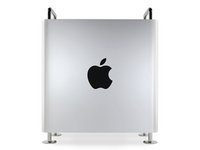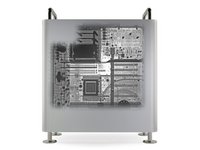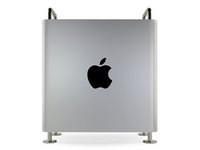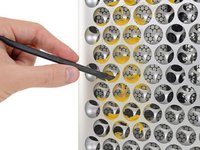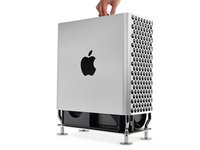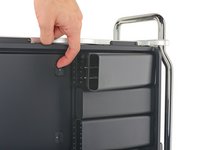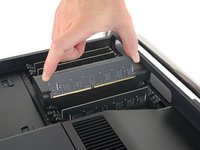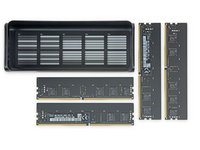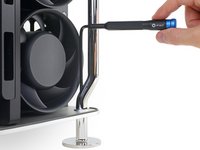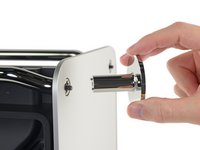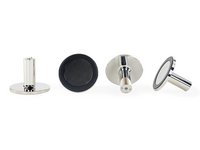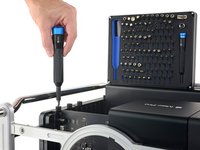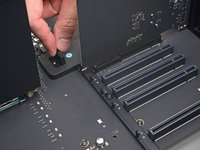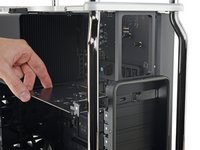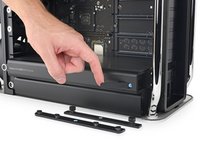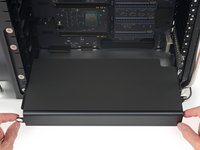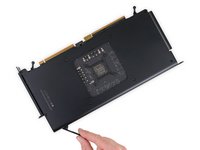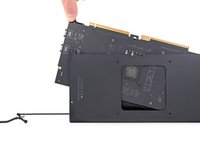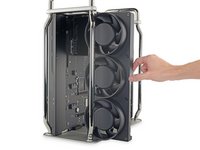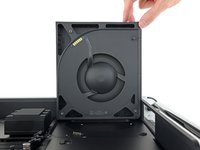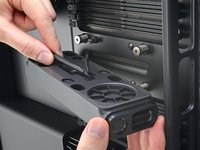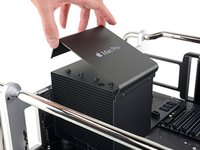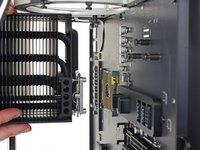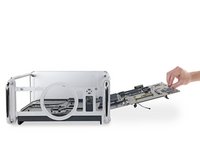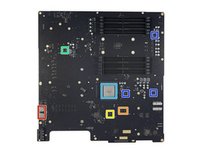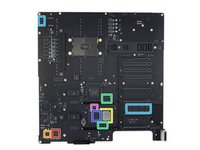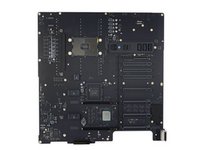Introduction
The Mac is back and more Pro than ever, throwing away the cylindrical “trash can” design in favor of something that resembles a computer. Its appearance may harken to the original Mac Pro from 2006, but can it compare in the repairability department? We dropped six thousand dollars and one block of hard cheddar to find out. Let’s tear it down.
Yearning for more teardowns? Follow us on Instagram, Twitter, and Facebook for all the latest teardown and repair news. For news delivered, sign up for our newsletter.
What you need
Video Overview
-
-
It may not be the expensive configuration handed out to so many YouTubers, but our base model Mac Pro will still put a dent in your
titanium Apple Cardwallet at a cool six grand, offering: -
8-core Intel Xeon with 24.5 MB of L3 cache and a 4.0 GHz max turbo frequency
-
32 GB (four 8 GB modules) of 2666 MHz DDR4 ECC Memory
-
AMD Radeon Pro 580X with 8 GB of GDDR5 VRAM
-
256 GB PCIe-based flash storage module
-
802.11ac Wi-Fi wireless networking and Bluetooth 5.0 wireless technology
-
Like the Mac Pro before it, this one is also "Assembled in USA" at a plant in Texas. They say everything's bigger in Texas, and this new Mac Pro is no exception.
-
-
-
From the side, the Mac Pro is about as Apple as they come. Huge, honkin' Apple logo? Check. Cold, hard stainless steel? Check. Precisely milled aluminum slabs? Check.
-
Ports are cool, but we're more excited about what's behind all that black plastic: eight PCIe slots, which add up to more upgradability than we've seen from any Apple product in a long time.
-
From above, you can spot two more USB-Cs and what looks like an inconspicuous power LED to the left of the power button.
-
We already got a look at the Mac Pro's two primary handles, but what's this third one up top?
-
Maybe it opens the computer? Nah, it can't be that easy.
-
-
-
Before we tear down, we ask our friends at Creative Electron to stuff our Mac Pro into their X-ray machine.
-
Unsurprisingly, this thing is so big that it wouldn't completely fit into the X-ray cabinet—but so far, it's looking a lot like a tower PC.
-
That's good news, everyone.
-
-
Tool used on this step:Halberd Spudger$2.99
-
Despite its cheese-grater appearance, this new Mac Pro cannot grate cheese. This important consumer advice is brought to you by iFixit, the company that wonders: why doesn't anybody send us review units?
-
Time to open the case. We came to this teardown armed with many tools, but so far all we need is our fingers.
-
Some informative dots tell us this handle rotates, and with surprising ease.
-
Like Johann Schmidt delicately handling the Tesseract, a twist and pull on this third handle uncovers everything hiding beneath.
-
-
-
The housing slides off with little effort or drama—no proprietary screws or adhesive in sight!
-
Inside, we get a peek at the locking mechanism, which looks awfully familiar...
-
A closer look reveals pogo pins under the power button that correspond to ...
-
... contacts on the housing. Removing the housing breaks the connection, cutting power to the machine. Neat!
-
-
-
Unfazed by the ominous array of black modules in the case, we pull the first switch we can find, and...
-
Voilà! Up pops the first memory cover, revealing two out of the four sticks of RAM that came with our base configuration model. (There's room for eight more sticks in there.)
-
Still no tools required for any of this—if you have opposable thumbs, you can replace this RAM (we even have some!). Somebody pinch us.
-
The cherry on top is the handy diagram on the insides of the RAM covers, showing which DIMM slots to populate with different amounts of memory.
-
-
-
-
The feet are held in place with just one screw each—although the screws themselves are buried deep in slots in the space frame pillars, making them a bit awkward to access. We make do with a 4 mm hex key and a Mako driver for extra leverage.
-
We didn't shell out the $400 for the wheel-y upgrade, so it's nice to know that we don't really need to drag this thing to the Apple store to swap its shoes.
-
-
Tool used on this step:Manta Driver Kit - 112 Bit Driver Kit$69.95
-
The I/O boards are held in place by Phillips head thumbscrews and can be loosened (and tightened) by hand. But our trusty Manta Driver Kit is always here to assist.
-
All PCIe cards are locked in place by a single switch (handily labeled as step 2).
-
This switch moves a rail with little hooks on it that secure anything in their path. In other words: one switch to remove them all, one switch to bind them.
-
-
-
Teardown Update: Let's take a closer look at this custom AMD Radeon Pro 580X video card module:
-
When you pull the release latch, it engages two rollers on the opposite side, which simultaneously undock the card and push it away from the
mothershipmotherboard. -
Unlike the module itself, the silicon inside does not come out with a clever lever! A few sneaky screws are hidden under a giant sticker atop the cooling fins, and then we have to carefully disengage the lever mechanism before we can finally pull out the card.
-
For our efforts, we are rewarded with the following:
-
The main event! AMD's Radeon Pro 580X, (an iteration of their Pro 500 series for Macs) built on their 14 nm Polaris architecture, featuring 36 compute units.
-
Two rows of Micron GDDR5 VRAM, totaling 8 GB
-
2x MegaChips MCDP2920, likely something akin to their MCDP2900 DisplayPort 1.4 to HDMI 2.0 converter
-
International Rectifier IR35217 buck controller (similar to the IR35211) and NXP's L6524 I/0 expander
-
-
-
What a pleasant surprise! Removing the blower fan housing reveals the teeny-tiny SSD.
-
We're happy to see a modular SSD, but not happy knowing it's bound to the T2 chip, meaning user-replacements are a no-go.
-
That said, there are plenty of other ways to add storage, so it's not a total loss!
-
-
-
The three-fan array comes out in one piece. It's held in place with six screws and connects to the logic board with spring contacts—no fussy cables to deal with!
-
The three tower fans pull cool air through the cheese-grater holes at the front, and push it across the logic board through the various heat sinks. Then the blower fan vacuums up the hot air and spits it out the back.
-
A few interesting things about this arrangement:
-
Most tower computers have dedicated fans for the CPU and GPU in addition to fans at the front & rear of the case. The Mac Pro just has front and rear fans, which supposedly provide enough cooling to keep it chill under stress.
-
Another thing most tower computers have: some sort of debris filter to get rid of particles in the air that the cooling fans pull in. Apple's engineers are on record saying they don't need that, but only time will tell how dusty these things get.
-
-
-
What's this? A little baby module! This one's nestled between two groups of DIMM slots and appears to be the speaker.
-
With basically everything else out of the way, we turn our attention to the brains of this whole operation: the CPU, currently trapped beneath its giant heat sink (and some very deeply hidden T15 Torx Plus screws).
-
With no CPU replacement guide to turn to, we call an audible and unscrew the heat sink bracket from the backside of the logic board—releasing both bracket and CPU (Intel Xeon W-3223) from the LGA 3647 socket.
-
-
-
Although the power button itself gets nifty pogo pins, the breakout board it's mounted to is one of the only things actually connected via physical cables. But it's dispatched easily enough, clearing a path to the logic board.
-
Finally, we slide the logic board out of its natural habitat.
-
Even by tower PC standards, this board is huge—reminding us more of an Xbox board than ye olde 2013 Mac Pro.
-
-
-
Our base model may look a bit bare, but there's still plenty of silicon on this massive slab:
-
2x aQuantia AQtion AQC107-B1-C multi-gigabit ethernet controller
-
2x Diodes Incorporated PI3DBS16 PCIe Thunderbolt 3 signal mux
-
Pericom (acquired by Diodes Incorporated) P17C9X PCIe packet switch
-
TPS 51980A TI 921 A57R buck converter
-
PLX Technology PEX8798-AB80B1 G 1907 CB007158 TA1BAN, probably a PCIe switch
-
3x Primarion (acquired by Infineon) PXE1610CDN, most likely PMIC
-
-
-
To continue, flip to Side B:
-
Apple APL1027 339S00606 T2 coprocessor
-
Apple 338S00342-A0 (likely Apple PMIC)
-
Intel C621 Chipset
-
6x Diodes Incorporated PI3DBS16 PCIe Thunderbolt 3 Signal Mux
-
10x Diodes Incorporated PI3EQX8904 PCIe ReDriver
-
2x Diodes Incorporated PI3PCIE3242A PCIe switch, and 2x Diodes Incorporated PI3PCIE3442A PCIe switch
-
NXP L6524 general purpose I/O expander
-
-
-
The new Mac Pro is a Fixmas miracle: beautiful, amazingly well put together, and a masterclass in repairability.
-
We love that a good portion of the modules can be swapped without tools; we love the use of (mostly) standard screws and connectors; we love the step numbers and diagrams for certain repairs right on the device; and most of all, we love the free public repair manuals and videos.
-
Despite the many things to love, however, Apple still keeps the keys to certain repairs, like the proprietary SSD. And some of Apple’s repair manuals include (or entirely comprise) a disclaimer insisting that you contact an Apple Authorized Service Provider, when in reality the repair could easily be done at your desk.
-
With 2019 in our rearview, we’re starting to wonder: maybe Microsoft and Apple aren’t making devices more repairable just for fun (or for us)—maybe those Right to Repair bills are starting to look seriously scary?
-
Motivations and quibbles aside, this is without a doubt the most repairable Apple product in recent memory. Let's give it a score.
-
- The opening procedure couldn’t be easier.
- Basic repairs and upgrades can be performed with standard tools or even no tools at all.
- Major components are highly modular and use industry-standard sockets and interfaces, making replacements and upgrades a snap.
- Apple provides some step numbers and diagrams right on the device, and publishes free repair manuals for some repairs to help you get it right.
- The SSD cards are modular, but custom-made by Apple, complicating replacement.
- If you need a replacement part that’s not on Apple’s limited list of approved repairs, you’ll likely pay a dizzying price—if you can find them at all.
Final Thoughts
Repairability Score


(10 is easiest to repair)
152 Guide Comments
Is it possible to upgrade processor after buying the computer?
And, Is it possible to use RAM from any manufacturer or we have to use Apple’s RAM modules?
We haven’t tested them yet, but to all appearances: Yes to processor upgrades, and yes to RAM upgrades. Both are modular, socketed, standard components.
Yes! 9to5mac already tested it. Here’s the video: https://www.youtube.com/watch?v=VHdUOJ6c...
@Gilmer Pelegrini, Jr - 9to5Mac only did RAM…CPU should be straight forward but good luck finding a W-3275M, W-3265M or W-3245(M).
I’ve been wondering the same! Has it been confirmed that the Xeons from the Mac Pro are the W-32XXM series? I have a W-3175X and I’m curious if it would work. It still uses the Intel C621 chipset found on these boards.
TJM -









